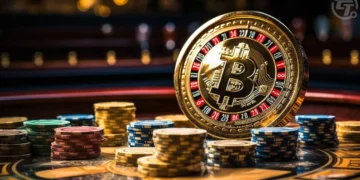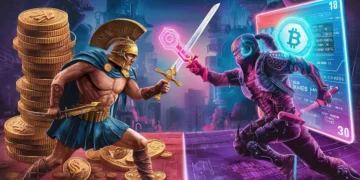Ever since blockchain technology made its way into the gaming world, developers and players alike have been searching for the perfect blend of fun and profitability. We’ve seen Play-to-Earn experiences dominate headlines, promising crypto rewards for players who dedicate time and effort to in-game tasks.
But lately, there’s another concept stirring up excitement in the blockchain community: Play-to-Mint games. If you’ve been curious about this emerging trend and what it means for the future of blockchain gaming, read on. I’m here to demystify the concept and show you why Play-to-Mint could be the next big thing.
What Is Play-to-Mint?
Think of Play-to-Mint as the cousin of Play-to-Earn. In a typical Play-to-Earn model, gamers complete missions or challenges and are rewarded in tokens. Play-to-Mint takes it a step further by allowing players to mint NFTs as they progress through the game. Instead of merely earning a fungible token, you’re actually creating something unique and collectible—a digital asset with provable ownership stored on a blockchain.
The idea is simple: by engaging in gameplay, you directly participate in the creation of NFTs. This transformation from player to creator offers an immersive experience that aligns perfectly with the metaverse concept: a space where digital and real-life economies intersect.
How Play-to-Mint Differs From Play-to-Earn
Asset Ownership
In Play-to-Earn, you typically earn a token that can be traded or used within the game’s ecosystem. In Play-to-Mint, you receive unique NFTs that can represent characters, items, or collectibles. Each NFT can be sold, traded, or used across different platforms, depending on cross-chain compatibility.
Long-Term Value
Cryptocurrencies are volatile assets and their value changes with market conditions. NFTs can hold or even increase in value based on rarity, community interest or game success. This dual potential – an NFT’s intrinsic and social value – appeals to collectors and gamers who love the thrill of finding something truly unique.
Community Building
Earning NFTs often fosters a sense of shared ownership. Players who mint NFTs become partial stakeholders in a project’s growth, leading to tighter community bonds and increased fan engagement.
Why Are Play-to-Mint Games Gaining Popularity?
Unique Digital Assets
Having a one-of-a-kind digital sword or rare in-game character gets people excited. People love to collect rare items and blockchain certifies your NFT is one of a kind.
Enhanced Engagement
Rather than mindlessly grinding for a token, players are more engaged when every new level or milestone could drop an NFT. This deeper involvement translates into a more enjoyable experience.
Speculative Potential
NFTs have been known to skyrocket when they gain traction in the market. Many gamers enter Play-to-Mint games to get in early, grab rare items and potentially sell them for more later.
Growth of the Metaverse
As the concept of the metaverse expands, the idea of digital ownership becomes more tangible and financially rewarding. Play-to-Mint is at the forefront, merging gameplay with creation in a way that aligns perfectly with GameFi (gaming and decentralized finance).
The Role of NFTs in Play-to-Mint Games
NFTs aren’t just pretty pictures or novelty items—they serve as the backbone of Play-to-Mint. Each NFT minted represents a unique digital property, verifiable through smart contracts on the blockchain. Here’s how they fit into the bigger picture:
-
Community Trust: When items are on-chain, everyone can see the transaction history, it promotes a trusted ecosystem.
For blockchain gaming enthusiasts, NFT gaming represents a chance to collect tangible value in digital form—something that has been lacking in many traditional games.

Potential Drawbacks and Challenges
While Play-to-Mint has a lot of promise, it’s not without hurdles:
Entry Costs and Gas Fees
Some cryptocurrency networks have high transaction fees for minting NFTs. This can deter new players from joining, especially if they’re just curious.
Regulatory Concerns
Governments worldwide are still figuring out how to categorize and regulate digital currencies and NFTs. Policy changes can impact the game’s economy.
Complex User Experience
Many blockchain based games require players to set up wallets, manage private keys and navigate decentralized exchanges. Simplifying these steps is key to mass adoption.
Market Oversaturation
As more developers scramble to create Play-to-Mint titles, the market risks becoming crowded. Games without genuine innovation might fade quickly, leaving only the truly engaging titles to thrive.
Are Play-to-Mint Games the Future of Blockchain Gaming?
If you’d asked a few years ago whether NFTs would revolutionize blockchain gaming, few people would have predicted the meteoric rise we’ve seen.
Today, Play-to-Mint games seem poised to be the next evolution—merging creation, collection, and gameplay into one package. Developers are exploring ways to integrate these mechanics into various genres, from role-playing adventures to competitive eSports.
Many experts argue that Play-to-Mint could sustain player interest longer than traditional Play-to-Earn models. Since each minted NFT holds potential sentimental (and financial) value, players have more than just a temporary stake in the game.
Tips for Getting Started With Play-to-Mint
Research the Game
Before you get started, read the whitepaper, tokenomics and community reputation. Make sure the roadmap and partnerships are in place.
Set Up a Secure Wallet
Managing your private keys is key. Choose a wallet that supports the game’s blockchain (e.g. Ethereum, Binance Smart Chain, or Polygon).
Understand the Minting Process
Know how items are minted and the gas fees. Know when to mint (e.g. during low network congestion) to save money.
Engage With the Community
Join Discord channels, Telegram groups or Twitter communities related to the game. You’ll find tips, strategies and even airdrops or exclusive mints.
Final Thoughts
The Play-to-Mint model has got gamers and investors excited by offering more than just token rewards. By combining gameplay with NFT creation these games give a sense of ownership that goes beyond the typical gaming experience. Sure there are challenges (fees, regulatory concerns, user onboarding) but the potential for deeper engagement and tradeable assets is hard to ignore.
is Play-to-Mint the next big thing in blockchain gaming? It certainly has all the ingredients to be a major player in the space. Whether you’re a casual gamer, a hardcore collector, or just curious about the intersection of cryptocurrency and entertainment, keep an eye on this space. It may very well redefine what it means to play, collect, and invest in the digital realm.
Ever since blockchain technology made its way into the gaming world, developers and players alike have been searching for the perfect blend of fun and profitability. We’ve seen Play-to-Earn experiences dominate headlines, promising crypto rewards for players who dedicate time and effort to in-game tasks.
But lately, there’s another concept stirring up excitement in the blockchain community: Play-to-Mint games. If you’ve been curious about this emerging trend and what it means for the future of blockchain gaming, read on. I’m here to demystify the concept and show you why Play-to-Mint could be the next big thing.
What Is Play-to-Mint?
Think of Play-to-Mint as the cousin of Play-to-Earn. In a typical Play-to-Earn model, gamers complete missions or challenges and are rewarded in tokens. Play-to-Mint takes it a step further by allowing players to mint NFTs as they progress through the game. Instead of merely earning a fungible token, you’re actually creating something unique and collectible—a digital asset with provable ownership stored on a blockchain.
The idea is simple: by engaging in gameplay, you directly participate in the creation of NFTs. This transformation from player to creator offers an immersive experience that aligns perfectly with the metaverse concept: a space where digital and real-life economies intersect.
How Play-to-Mint Differs From Play-to-Earn
Asset Ownership
In Play-to-Earn, you typically earn a token that can be traded or used within the game’s ecosystem. In Play-to-Mint, you receive unique NFTs that can represent characters, items, or collectibles. Each NFT can be sold, traded, or used across different platforms, depending on cross-chain compatibility.
Long-Term Value
Cryptocurrencies are volatile assets and their value changes with market conditions. NFTs can hold or even increase in value based on rarity, community interest or game success. This dual potential – an NFT’s intrinsic and social value – appeals to collectors and gamers who love the thrill of finding something truly unique.
Community Building
Earning NFTs often fosters a sense of shared ownership. Players who mint NFTs become partial stakeholders in a project’s growth, leading to tighter community bonds and increased fan engagement.
Why Are Play-to-Mint Games Gaining Popularity?
Unique Digital Assets
Having a one-of-a-kind digital sword or rare in-game character gets people excited. People love to collect rare items and blockchain certifies your NFT is one of a kind.
Enhanced Engagement
Rather than mindlessly grinding for a token, players are more engaged when every new level or milestone could drop an NFT. This deeper involvement translates into a more enjoyable experience.
Speculative Potential
NFTs have been known to skyrocket when they gain traction in the market. Many gamers enter Play-to-Mint games to get in early, grab rare items and potentially sell them for more later.
Growth of the Metaverse
As the concept of the metaverse expands, the idea of digital ownership becomes more tangible and financially rewarding. Play-to-Mint is at the forefront, merging gameplay with creation in a way that aligns perfectly with GameFi (gaming and decentralized finance).
The Role of NFTs in Play-to-Mint Games
NFTs aren’t just pretty pictures or novelty items—they serve as the backbone of Play-to-Mint. Each NFT minted represents a unique digital property, verifiable through smart contracts on the blockchain. Here’s how they fit into the bigger picture:
-
Community Trust: When items are on-chain, everyone can see the transaction history, it promotes a trusted ecosystem.
For blockchain gaming enthusiasts, NFT gaming represents a chance to collect tangible value in digital form—something that has been lacking in many traditional games.

Potential Drawbacks and Challenges
While Play-to-Mint has a lot of promise, it’s not without hurdles:
Entry Costs and Gas Fees
Some cryptocurrency networks have high transaction fees for minting NFTs. This can deter new players from joining, especially if they’re just curious.
Regulatory Concerns
Governments worldwide are still figuring out how to categorize and regulate digital currencies and NFTs. Policy changes can impact the game’s economy.
Complex User Experience
Many blockchain based games require players to set up wallets, manage private keys and navigate decentralized exchanges. Simplifying these steps is key to mass adoption.
Market Oversaturation
As more developers scramble to create Play-to-Mint titles, the market risks becoming crowded. Games without genuine innovation might fade quickly, leaving only the truly engaging titles to thrive.
Are Play-to-Mint Games the Future of Blockchain Gaming?
If you’d asked a few years ago whether NFTs would revolutionize blockchain gaming, few people would have predicted the meteoric rise we’ve seen.
Today, Play-to-Mint games seem poised to be the next evolution—merging creation, collection, and gameplay into one package. Developers are exploring ways to integrate these mechanics into various genres, from role-playing adventures to competitive eSports.
Many experts argue that Play-to-Mint could sustain player interest longer than traditional Play-to-Earn models. Since each minted NFT holds potential sentimental (and financial) value, players have more than just a temporary stake in the game.
Tips for Getting Started With Play-to-Mint
Research the Game
Before you get started, read the whitepaper, tokenomics and community reputation. Make sure the roadmap and partnerships are in place.
Set Up a Secure Wallet
Managing your private keys is key. Choose a wallet that supports the game’s blockchain (e.g. Ethereum, Binance Smart Chain, or Polygon).
Understand the Minting Process
Know how items are minted and the gas fees. Know when to mint (e.g. during low network congestion) to save money.
Engage With the Community
Join Discord channels, Telegram groups or Twitter communities related to the game. You’ll find tips, strategies and even airdrops or exclusive mints.
Final Thoughts
The Play-to-Mint model has got gamers and investors excited by offering more than just token rewards. By combining gameplay with NFT creation these games give a sense of ownership that goes beyond the typical gaming experience. Sure there are challenges (fees, regulatory concerns, user onboarding) but the potential for deeper engagement and tradeable assets is hard to ignore.
is Play-to-Mint the next big thing in blockchain gaming? It certainly has all the ingredients to be a major player in the space. Whether you’re a casual gamer, a hardcore collector, or just curious about the intersection of cryptocurrency and entertainment, keep an eye on this space. It may very well redefine what it means to play, collect, and invest in the digital realm.





















































































get clomid online can you buy cheap clomid prices order clomiphene without rx can i order clomiphene without insurance cost cheap clomid without a prescription where to get cheap clomid no prescription where can i buy generic clomid price
I couldn’t resist commenting. Profoundly written!
I am in point of fact delighted to gleam at this blog posts which consists of tons of useful facts, thanks towards providing such data.
azithromycin online buy – buy floxin generic order metronidazole online cheap
rybelsus online – where can i buy rybelsus buy cyproheptadine 4mg
order motilium online cheap – order generic sumycin oral flexeril
buy inderal 20mg sale – order inderal 10mg generic methotrexate 2.5mg usa
augmentin 1000mg oral – atbioinfo buy ampicillin without a prescription
buy generic esomeprazole – https://anexamate.com/ nexium 40mg pills
order medex – cou mamide cozaar online buy
mobic 7.5mg pills – relieve pain buy mobic generic
generic prednisone – corticosteroid order deltasone 10mg online
medication for ed – https://fastedtotake.com/ buy ed pills paypal
buy generic amoxil online – https://combamoxi.com/ cheap amoxicillin pills
generic fluconazole 100mg – this diflucan 100mg tablet
cenforce 50mg generic – https://cenforcers.com/# cenforce 100mg cheap
buy cheap cialis online with mastercard – this canadian pharmacy cialis 20mg
cialis softabs online – https://strongtadafl.com/# buy cialis shipment to russia
The reconditeness in this ruined is exceptional. click
viagra buy china – https://strongvpls.com/# buy herbal viagra online
With thanks. Loads of expertise! buy amoxil paypal
I couldn’t turn down commenting. Profoundly written! https://ursxdol.com/get-cialis-professional/
This is the kind of scribble literary works I in fact appreciate. https://prohnrg.com/product/get-allopurinol-pills/
This is the amicable of content I enjoy reading. cialis super active 20 mg gГ©nГ©rique
More posts like this would force the blogosphere more useful. https://ondactone.com/product/domperidone/
I’ll certainly bring to skim more.
https://proisotrepl.com/product/colchicine/
This is the gentle of criticism I positively appreciate. http://zgyhsj.com/space-uid-977928.html
forxiga price – https://janozin.com/# order dapagliflozin 10 mg generic
xenical for sale – https://asacostat.com/ buy generic xenical over the counter
Thanks on putting this up. It’s well done. http://bbs.yongrenqianyou.com/home.php?mod=space&uid=4277947&do=profile